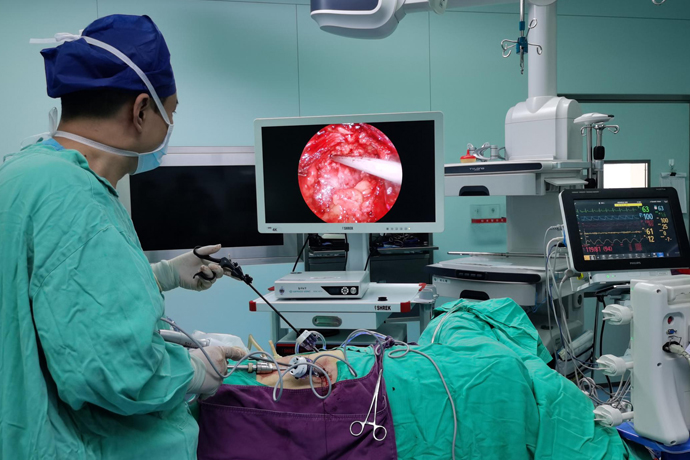【Hepatobiliary Surgery Laparoscopy】Partial Pancreatectomy
Release time: 17 Jun 2025 Author:Shrek
Pancreatitis is one of the diseases frequently seen clinically. It is damage caused by the digestion of pancreatic tissue by its own trypsin. Severe pancreatic necrosis combined with infection or abscess requires timely surgical treatment.

Under normal circumstances, pancreatic juice will not stimulate pancreatic tissue, let alone destroy its own pancreatic tissue. In some pathological conditions, such as stone tumors and other blockages, bile refluxes into the pancreas and penetrates the pancreatic tissue, causing the pancreas itself to be digested and causing pancreatic inflammation. Most patients suddenly develop obvious abdominal pain accompanied by nausea and vomiting after overeating, and sometimes fever. In severe cases, shock symptoms such as paleness, cold sweats, weak pulse, and drop in blood pressure may occur.
Mild pancreatitis can be replenished with body fluids, replenished electrolytes, antispasmodic and analgesic, and inhibited pancreatic secretion through infusion. Timely antibiotic treatment is generally required. Most cases can be completely cured with this conservative approach. Severe pancreatitis, such as pancreatic abscess, complicated infection, or pancreatic pseudocyst, should be treated with surgery in a timely manner.
Introduction to surgical methods
After endotracheal intubation and general anesthesia, lie down in the supine position and perform routine disinfection and draping. Establish 5 operating holes of the laparoscope and start the operation. After the laparoscope enters the abdominal cavity, a comprehensive examination is first performed to see if there is tumor spread in the abdominal cavity. Then the gastrocolic ligament is incised with an ultrasonic scalpel to expose the body and tail of the pancreas, and the relationship between the pancreas, mass and surrounding tissue is explored.
The normal pancreatic tissue on the right side of the tumor was pulled up using the hanging method, and the splenic artery and vein were processed. The pancreas was cut off using an endoscopic cutting stapler (EC60, Johnson & Johnson, USA). The pancreas and spleen were freed from the broken end of the pancreas from right to left, and the splenocolic ligament and splenorenal ligament were cut respectively until the entire specimen was freed. The resected specimens are placed in a special laparoscopic bag and taken out periumbilically. After the wound is rinsed and there is no bleeding, a drainage tube is placed on the pancreatic bed and the incision is closed.
Case
The patient was an elderly female, 65 years old, who was transferred to the intensive care unit because of abdominal pain for 4 days, which worsened and accompanied by chest tightness and shortness of breath for 2 days.
CT scan showed a large fluid dark area around the pancreas. Necrotic tissue was considered, and peripancreatic necrotic tissue puncture and drainage was performed under CT guidance.
Surgical steps
Pneumoperitoneum is established, enters the abdomen, and the peritoneum has been completely eaten away. The gastrocolic ligament is opened within the vascular arch of the greater curvature of the stomach. Open the lower edge of the pancreas and find necrotic tissue. The debridement technique can be summarized as: light gathering, slow twisting, wiping and then picking.
Finally, two double cannulas and two ordinary drainage tubes were placed.
Whether patients with pancreatitis require surgery or not, they should strictly fast and use gastrointestinal tubes for gastrointestinal decompression. After a period of treatment, the abdominal pain disappears and there are no other symptoms. You can gradually resume your diet. If you usually have biliary tract diseases, such as biliary stones, cholecystitis and other diseases, you should treat them as soon as possible to avoid causing pancreatitis attacks. Try to reduce drinking as much as possible, or not drink. Long-term or large amounts of drinking can damage the liver, pancreas and other organs. The body's resistance and anti-infection ability are relatively low. If you drink a lot of alcohol suddenly, it can lead to an attack of pancreatitis. You must eat regularly and avoid overeating, otherwise it will cause gastrointestinal dysfunction and pancreatitis.

- Recommended news
- 【General Surgery Laparoscopy】Cholecystectomy
- Surgery Steps of Hysteroscopy for Intrauterine Adhesion
- [Gynecological Hysteroscopy] Techniques for Preventing and Treating Complications of Hysteroscopic Surgery
- [Gynecological Hysteroscopy] Hysteroscopic Adhesiolysis
- [Gynecological Hysteroscopy] IUD Removal under Hysteroscopy